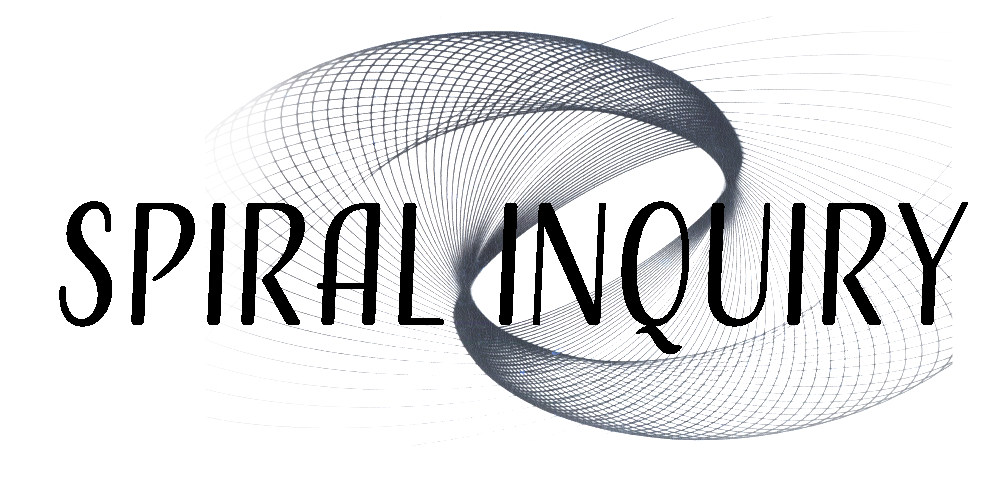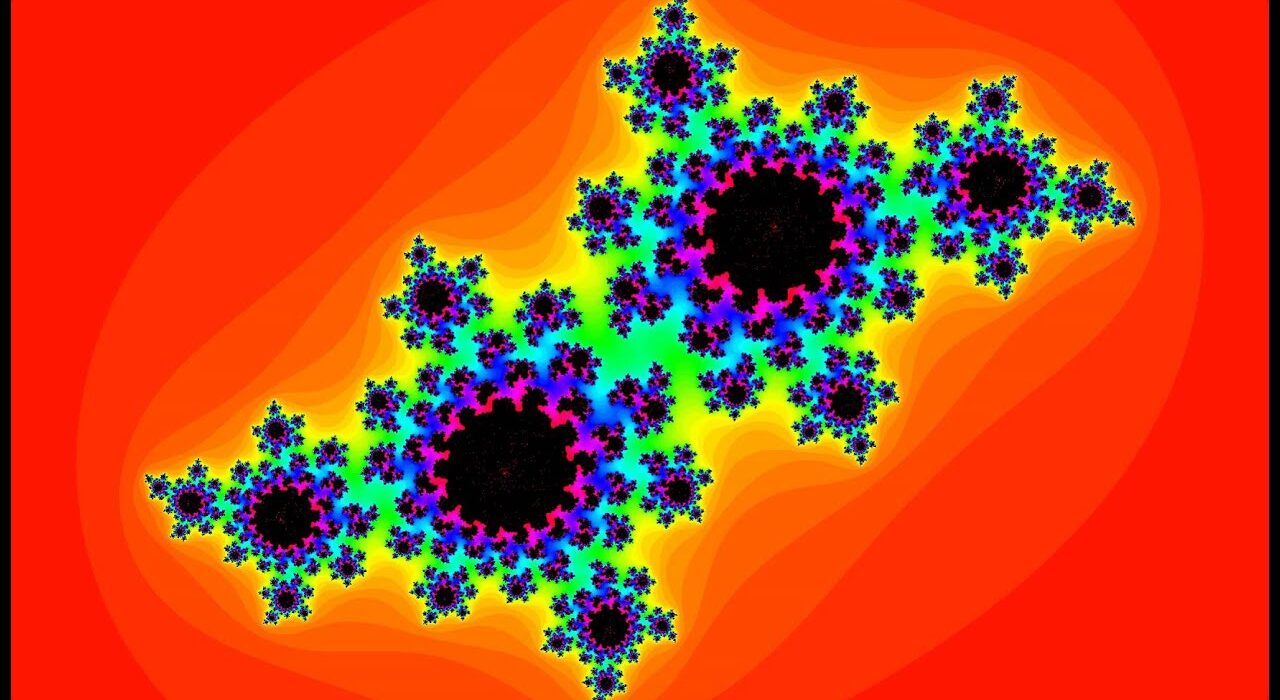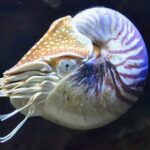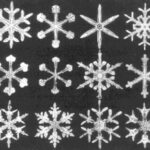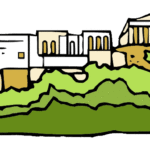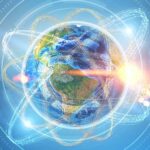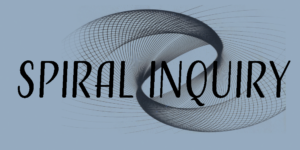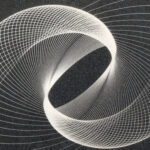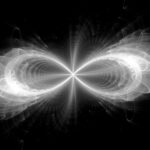To make sense of this crazy, wonderful world, one has to make a choice: What is the purpose of creation and what is its value to us? Why am I meant to be? (Episode 6)
We have a choice to make. About this, we have no choice.
This conundrum is one variant of a critical peculiarity of the reality that we all experience. Earlier, in Episode 6, we explored the confusion about randomness and purpose in the universe and in our lives. We also followed, in Episode 4, the reductionist path in search of a Theory of Everything, peeling back the layers from the whole to nothing. Why are these things so difficult? Why is everything so confused?

Spirals and reflections in a human eye.
Being Self-Referential
The conscious ability to reflect, and the resulting capacity for self-reflection, is a particularly important feature of the world we live in. In Episode 2, we discussed the Incompleteness Theorems of Kurt Gödel that proved that our logic, if consistent, will always be incomplete. The proof of those theorems relies on a particular category of logical statements, statements that refer to themselves. The sentence “This statement contains five words.” is an example. It is perfectly sensible, and it is true. “This statement is written in cursive.” is also sensible, however it is false. What happens when you consider the simple sentence “This statement is false.”? If true, the statement contradicts itself. If false, it curls back and bites its own tail.
This curious linguistic sample is known as the liar’s paradox. It has created significant difficulties in the foundations of mathematics including both logic and set theory. Gödel’s proof confirms that being consistent means the truth will always be incomplete. Self-referential logical systems simply cannot avoid this paradox.
Humans are self-referential systems; we are conscious, aware, attentive, reflective, and contemplative and we make plans, intentions and choices for ourselves. Following Gödel, it would seem that humans, in seeking to be rational and logically consistent, would inevitably find that the truth is incomplete.
The universe is also a self-referential system. We are a product of the universe, and we are observing it. In quantum physics, the waveform does not collapse (e.g. things don’t “happen”) unless the event is “observed.” Perhaps the paradoxes we find in relativity, quantum physics, causation and purpose are the Gödellian consequence of the self-referential nature of reality. In which case, the universe is not entirely accessible to science — some truths will always be beyond reach.
Reflections on The Infinite
Infinity, for example, will always be beyond reach. Yet, mathematicians and physicists rely on the concept of infinity all the time. Numbers, for example, are an infinite set; and calculus is a valuable technique based on infinitesimals. But no mathematician or computer will ever count to infinity and no physicist will ever observe it.
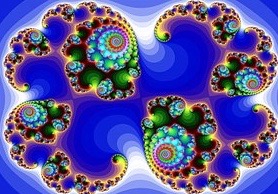
Finite color image of a “Julia Set”, a complex infinite fractal.
There’s an interesting thought experiment that reveals some of the strange properties of infinity. Imagine 100 monkeys typing (presumably randomly) on 100 typewriters for a limitless period of time. Eventually, hidden somewhere in the seemingly endless streams of nonsense, they would produce all of the works of Shakespeare. So, what is the difference between an endless stream of nonsense produced by typing monkeys, and the very meaningful works of Shakespeare? The difference can only be observed by a reflecting intelligence.
Consider then the stream of experiences that make up our lives. Many of those experiences may seem to be random — some believe they are all random. But clearly, there are events in human lives that are transformational – surviving a plane crash; falling in love; choosing, or falling into, a career; getting (or surviving) a disease; experiencing a transcendent presence. In light of who we each turn out to be, such experiences are no accident. As some will say, looking back, “this was meant to be.” While no one can prove such a claim, neither can anyone ever disprove it. Meaning does not arise from a collection of life experiences, but from the observations of a reflecting intelligence that recognizes the threads and patterns that are meaningful.
Reciprocity
Reflection is, necessarily, two-way. There is the observer, and the observed. In this sense, reflection is a reciprocal relationship. Reciprocity implies that if you have the one – then you must have the other.
Infinity, the idea of endlessness that is always beyond reach, also has a reciprocal, the concept of nothingness. Zero, the null set, may seem to be so much simpler than infinity, and yet neither can be concretely conceived. The very act of conceiving nothing gives it substance, effectively denying its true nature as nothing. Similarly, the act of conceiving infinity is fruitless, since the very thought seeks to bound what is unbounded.
In an important sense, zero and infinity are intimately intertwined yet eternally distinct. Consider the simple formula: x = 1 / y. If we let y get bigger and bigger, the value of x gets smaller and smaller. We can make y arbitrarily large, and the value of x arbitrarily small, so we say the mathematical limit of x, as y approaches infinity, is zero. Zero and infinity are reciprocal.
In quantum physics, every quantum event manifests a relationship between the observer and that which is observed. The relationship is reciprocal — each side requires the other. The complementarity principle holds that quantum states manifest as both waves and particles — the two are mutually exclusive, but inextricably linked. Even Newton’s third law of motion draws on the concept of reciprocity – every action has an equal and opposite reaction. From a cosmic viewpoint, these reciprocal relationships permeate the universe – at the limits of thought, everything is connected to everything else in a continuous chain of reciprocity.
Humans are also reciprocal. We are individuals, yet we are inextricably and reciprocally connected to other humans through genetic and evolutionary heritage, as well as through language and culture. We are also eminently social creatures, defining ourselves, and the meaning of our lives, through our relationships. We care, and are cared for. We love, and are loved. These reciprocal connections weave through time and space to every human now alive and every human that ever lived. In the broadest sense the threads connect us to all living things and, ultimately, to all times and places.
A Theory of Everything
So what do we make of our reciprocal relationship to the totality of all that is, to all of experience? Can there ever be a theory that captures this totality, a truly all-encompassing TOE?
From an empirical perspective, the answer is no. Our logical foundation is inadequate. Our experiential evidence is inconclusive. Our theoretical framework is riddled with incompatibilities. These difficulties all flow from the self-referential nature of consciousness, life and the universe.
Of course, this does not stop the theoretical physicists, in their quest to avoid these difficulties, from postulating the model of an infinite multiverse. This is a theory in which everything that is possible exists somewhere. Each time a choice is being made, by a quantum particle or a human agent, two alternate universes are created, one for each possibility. While we live in the world where the physical fine-tuning constants are specific values, there are infinitely many other worlds where those constants assume all possible different values. Any possible configurations of reality that are mathematically possible, are physically manifested in some reality, far distant as it may be from ours. In this model, we no longer need be concerned with how choices actually change the world – worlds are there for all possible choices. Nor do we need to distinguish between randomness and purpose – any and all outcomes exist in one place or another, so there is need to make a distinction. In such a model, it can truly be said, that everything is everything.
Sadly, when everything is everything, then nothing means anything.
Abstract image of consciousness permeating the universe.
There is a relatively much simpler, some would say simplistic, model that works much better in addressing the theoretical difficulties, one that provides a useful, flexible framework for further inquiry. That model is the premise that finite reality is the creation of an infinite and eternal conscious intelligence (God). This creation includes a spiritual (non-physical) realm as well as the physical universe. The entirety of this creation is guided by conscious intention, manifested in the process of emergent evolution, the driving force of which is love (reciprocal attraction and mutual cooperation). The purpose of this creation is, ultimately, to facilitate communion: a conscious, reciprocal sharing of joy, gratitude and mutual lovingkindness.
This seems like the wiser choice.
Conclusion: Episode 8 – Integrating Knowledge and Faith
Episode 1 – Sources of Faith
Episode 2 – The Downward Spiral
Episode 3 – Minding the Gaps
Episode 4 – Peeling Back the Layers
Episode 5 – Love’s Embrace
Episode 6 – What is Meant to Be?
